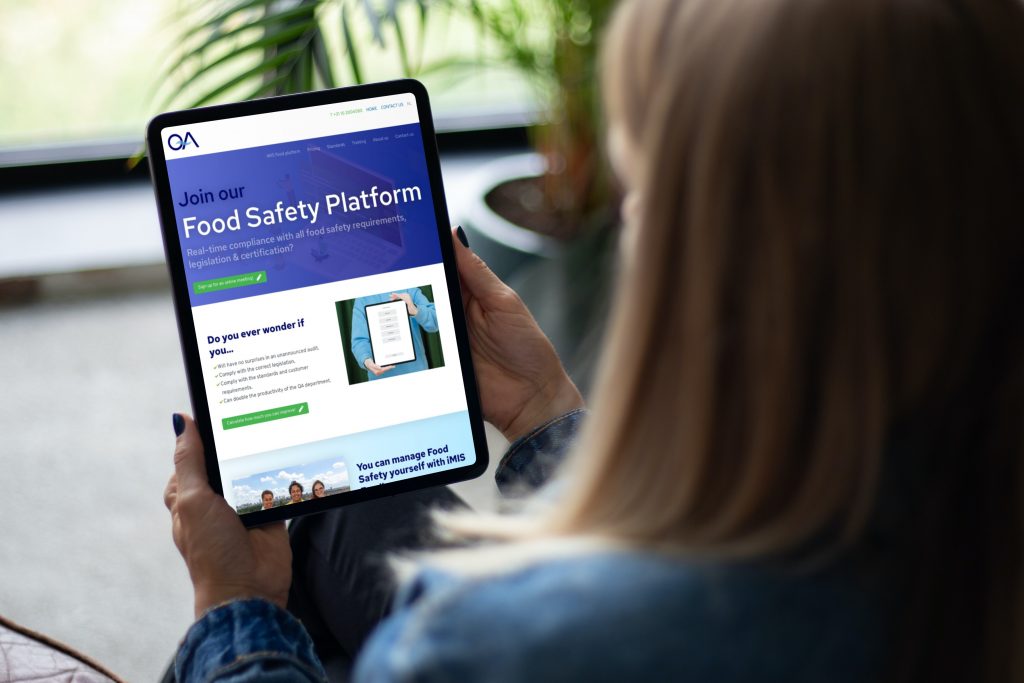General review food company
For this general review, multiple topics like microbiology and packaging will be discussed.
General review: Microbiological examination
The company is guided and advised by an external agency in the field of integrated quality assurance. This quality external agency also carries out chemical and microbiological studies.
The laboratory carries out its testing activities in such a way as to meet the requirements set out in the Dutch standard NEN-EN-ISO / IEC 17025. In this way, it also meets the needs of customers and legislative authorities. The laboratory has quality control procedures to control the validity of the tests performed. The resulting data is recorded in order to detect trends and, where possible, to apply statistical methods to evaluate the results. This follow-up is planned and evaluated. This monitoring includes the following:
- Regular use of certified reference materials and/or internal quality controls based on secondary reference materials.
- Participation in inter-laboratory comparisons or proficiency testing programs.
- Repeat the test using the same or different methods.
- New test or calibration of saved objects.
Technical staff concentrate on laboratory examinations. Technical employees are directly supervised by management and are responsible for the results of the work carried out. Technical employees participate in making the technical capacities of the company more explicit. They are focused internally in accordance with Dutch standard NEN-EN-ISO / IEC 17025 and ISO standards and comply with quality instructions. The technical employees are sufficiently trained (License, bachelor’s or technological diploma) and have sufficient experience to carry out the required analyzes. Regarding: sample collection and transport.
General review: Taking samples
It is important that the laboratory takes a sample that fully reflects the product. The sample must not be damaged or altered by transport or storage. Sampling should not affect the existing microbial state of the product to be sampled. This is usually not a problem for products in individual packages. If the units are so large that they cannot be sampled in their entirety, some should be wrapped in sterile material. In addition, no more than three-quarters of the space should be filled to avoid spillage and to allow the sample to be thoroughly mixed prior to examination. The transfer is done aseptically with sterile tools to avoid any contamination. If the tool is used multiple times at the sampling site, intermediate cleaning and sterilization is required. Instead of re-sterilizing tools, disposable sterile tools can be used.
General review: Transport
The transport must be carried out correctly and quickly so that the total microorganisms in the sample do not change during transport. The following storage temperatures should be used:
- Stable products: room temperature.
- Fresh and chilled products: between 0 and 4 degrees Celsius.
- Frozen or frozen products: below -18 degrees Celsius.
- Pasteurized and related products: between 0 and 4 degrees Celsius.
- Perishable products: between 0 and 4 degrees Celsius. Please note: sensitive products (i.e. fresh fish) must be stored between 0 and 2 degrees Celsius. Perishable products should be transported in sealed packages to prevent leakage.
Sampling takes place with the inspection agency. Products are examined after production and at the end of their expiration date. All with article 2073 as a guideline.
The results are evaluated and the trends are analyzed. If some products/product groups are not compliant, improvement measures are taken:
- Adjust the product;
- Adjust the recipe;
- Hygiene instruction;
- Adjust the production process;
- Change of raw materials and / or additives.
If a sample is measured to be microbiologically unsatisfactory, a counter sample is taken within 3 weeks. If this also deviates, a search is made to analyze the anomaly and action is taken.
The water is tested 4 times a year. The water is tested for the following parameters:
- Total number of colonies per ml at 22 ° C.
- Total number of colonies per ml at 36 ° C.
- Coliforms per 100 ml.
- Thermo tolerant coliforms per 100 ml.
- Faecal enterococcus per 100 ml.
- Traces of sulphite reducing Clostridia per 100 ml. An examination report is requested each quarter.
If necessary, tests of challenge and worst-case tests are carried out in consultation with the design office.
General review: Manual controls
Although many production processes are automated, employee personal hygiene plays an important role in the preparation of many foods. Often, manual contact with production cannot be reduced. Hands can be contaminated with microorganisms in different ways. For example, the skin is still home to the skin’s own bacteria, the so-called residents. The main representatives of this group are micrococci, staphylococci, propionibacteria and corynebacteria. In addition, the hands are often contaminated from the outside through contact with the environment, which is called transient contamination. These can come from the own body (nose, mouth, pharynx or gastrointestinal tract) or from the environment in the broadest sense (other people, materials, pets, etc.) . The hallmark of transients is that they do not colonize (multiply) on the skin like residents, but can survive for a specified time. During this time, they can be transferred to food by the hands. An exception is Staphylococcus aureus, which can colonize on the skin.
The fingerprint method can be used to examine the presence of certain bacteria (eg Enterobacteriaceae, Staphylococcus aureus) on the hands.
Calculate the total Colony Forming Units (CFU) for 5 fingers. Frequency: 1x every 3 months.
If the standard is exceeded, the handwashing procedure will again be discussed with the person in question. After which resampling takes place. This is repeated until the desired results are achieved.
General review: Packaging
All packaging or packaging equipment is suitable for its intended use and is tested for possible contamination and dangers (migration) with regard to the product and the consumer. Efficient and up-to-date test reports are available.
General review: Organoleptic examination
Along with microbiological testing, products are tested for taste, color and odor. This is done after production and at the end of the shelf life. These tests determine whether the products meet and continue to meet the correct quality requirements.
In the event of an anomaly, an attempt is made to find the cause. This occurs in the event of repeated anomalies of the counter samples. Depending on the cause, steps can be taken to improve:
- Adjust the recipe;
- Adjust the raw material / additive;
- Adjust the production process.
General review: Glove checks
For each batch of gloves, 5 gloves are checked for possible leaks and their appearance. If this is correct, the products are allowed to be used. In the event of anomalies, the products will be returned to the supplier.
General review: Assessment of exam results
The assessment of the examination results should be recorded. In our company, all sample results were found to be correct unless an anomaly was found. This is specifically named and actions are taken in response to the outcome. Actions can include:
1. Verification of the sampling method by the laboratory (by strange results);
2. Correction of the product, if possible;
3. Corrective actions for the product, process, production areas and personnel;
4. If necessary, this process can be reported through the iMIS audit.
Related articles to Can you provide a general review for a food company?
Many customers and visitors to this page 'Can you provide a general review for a food company?' also viewed the articles and manuals listed below:



